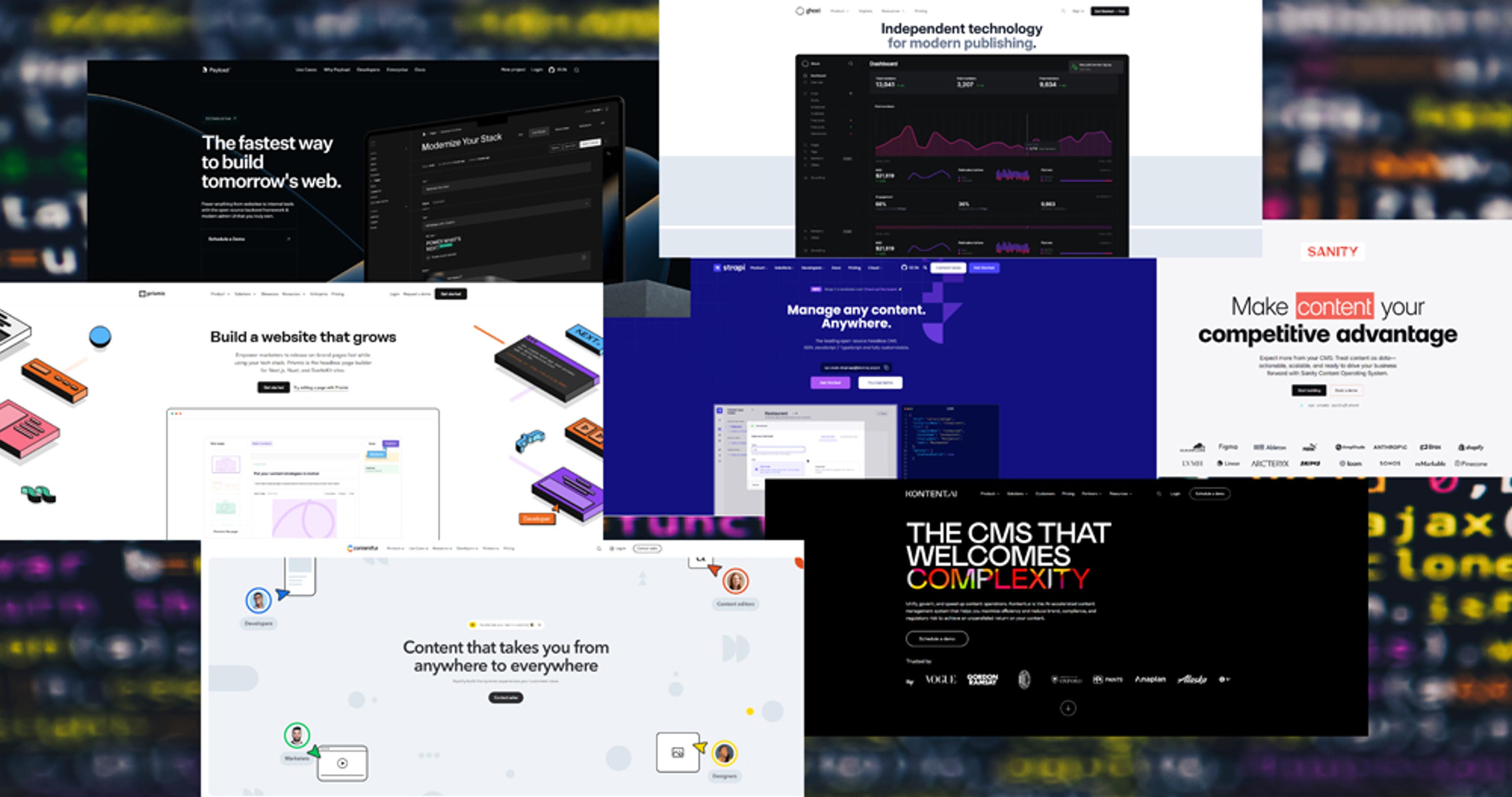7 Of The Most Popular Headless CMS Systems in 2024

In this, our second article on Headless Content Management System (CMS) website technologies and development; we are going to focus on the actual CMS platforms that can be used to develop a Headless CMS based website. If you haven’t already, please feel free to read our first article on Exploring Headless CMS: The Modern Approach to Content Management to get caught up.
To summarize, the Headless CMS is not not some monster from a 1960’s horror film - it is instead a modern approach to website development offering a flexible solution for managing and delivering content via websites. By separating content management from presentation - headless CMS platforms offer enhanced customization, scalability, speed and integration capabilities. As digital content continues to evolve, exploring a headless CMS could be a game-changer for website projects and businesses.
WHICH HEADLESS CMS FIT YOU?
When choosing a headless CMS platform, it's important to consider factors like scalability, flexibility, ease of integration, and the specific needs of your project. For instance, a marketing website may prioritize a platform with strong content management, SEO tools, and integration with marketing automation software, making platforms like Contentful or Prismic ideal choices.
An e-commerce website, on the other hand, requires a CMS that can handle high volumes of dynamic content, integrate with payment gateways, and offer real-time updates, which makes Strapi or Payload more suitable due to their customization and control features.
For a community or forum website, collaboration and real-time content updates are key, making platforms like Sanity or Ghost great options with their real-time editing and user-friendly interfaces.
Content-heavy sites such as blogs may favor Ghost or Payload for their built-in SEO features and fast performance, while enterprise-level projects needing multiple teams or advanced personalization might look to Kontent by Kentico for its robust collaboration and security features.
Ultimately, the type of website you're building significantly impacts which CMS will best fit your workflow and technical requirements, and it is these considerations as well as future roadmap objectives that most affect which Headless CMS will be best for your website project.

PLATFORMS FOR CONTENT
To help you narrow down which Headless CMS you might want to use, here are what we feel are the top 7 most popular headless CMS platforms that are making waves in the web development world:
1. Contentful
Contentful is a leading headless CMS platform known for its flexibility and ease of use. It allows developers to create, manage, and distribute content across multiple channels seamlessly. With a powerful API and a user-friendly interface, Contentful is highly favored by both developers and content creators. It supports various programming languages and frameworks, making it a versatile choice for projects of any scale.
Key Features:
- RESTful API and GraphQL support
- Rich text editing with media embedding
- Webhooks for real-time updates
- Integration with popular tools like Gatsby and Next.js
- Extensive plugin ecosystem
2. Strapi
Strapi is an open-source headless CMS that gives developers full control over the content management process. It’s known for its customization capabilities, allowing you to tailor the CMS to your specific needs. Strapi supports both REST and GraphQL APIs, making it a go-to choice for developers who require a flexible and scalable solution.
Key Features:
- Fully customizable and extensible
- Self-hosted with support for various databases
- Role-based access control (RBAC)
- Plugin ecosystem for adding functionalities
- Multilingual content support
3. Sanity
Sanity is a real-time headless CMS that provides a collaborative environment for content creators and developers. It stands out with its highly customizable content model and a rich text editor called Portable Text. Sanity’s API-first approach allows developers to deliver content in any format to any platform, making it ideal for complex content needs. ScreamingBox is currently using Sanity on our current website, but will be moving to Payload (See #7) to get SEO and additional formatting options.
Key Features:
- Real-time collaboration and editing
- Portable Text editor for rich content
- Flexible content modeling with JSON schema
- GROQ query language and GraphQL support
- Extensive third-party integrations and plugins
Check out our Podcast with the Founder of Sanity.io
4. Prismic
Prismic is a SaaS-based headless CMS that emphasizes simplicity and developer productivity. It offers a visual editor for content creators while providing developers with a powerful API to fetch and display content. Prismic is particularly popular among developers who want a straightforward yet effective solution for managing and delivering content.
Key Features:
- Slice Machine for component-based content modeling
- Rich text editor with media embedding
- Integration with popular frameworks like Vue.js and React
- Multi-language support
- Built-in CDN for fast content delivery
5. Ghost
Ghost is an open-source headless CMS tailored for content-focused websites, particularly blogs and publications. It combines the flexibility of a headless CMS with the simplicity of a traditional CMS, offering a clean and intuitive interface for content creators. Ghost is built with Node.js, making it a fast and modern solution for developers.
Key Features:
- REST API and GraphQL support
- Built-in SEO and AMP support
- Markdown editor for content creation
- Native integration with various third-party tools
- Secure and scalable with robust caching
6. Kontent
Kontent by Kentico is a cloud-based headless CMS designed to help enterprises manage their content across multiple channels and platforms. Known for its strong focus on collaboration and enterprise-grade features, Kontent allows teams to work together efficiently, delivering personalized experiences to users. It provides a robust API and a flexible content model that developers can easily integrate into their existing workflows.
Key Features:
- Collaboration Tools: Kontent offers in-context comments, workflow management, and approval processes, making it easier for teams to collaborate on content.
- API-first Approach: With RESTful APIs and SDKs for various languages, Kontent enables seamless integration with your tech stack.
- Personalization and Localization: It supports advanced content personalization and multi-language content delivery, catering to global audiences.
- Content Modeling: Developers can create custom content types and model them according to project needs, ensuring flexibility and scalability.
- Enterprise-grade Security: Kontent is built with enterprise needs in mind, offering role-based access control (RBAC), single sign-on (SSO), and other security features.
Check out our Podcast with Kontent.ai
7. Payload
Payload is a modern, developer-first headless CMS that stands out for its deep customization and developer-centric approach. Unlike many headless CMS platforms, Payload is self-hosted and built with Node.js, allowing developers to have complete control over their CMS infrastructure. It’s designed to be both powerful and flexible, offering a high degree of customization without compromising on performance or ease of use. ScreamingBox has chosen Payload as the Headless CMS for our new website which we are currently building.
Key Features:
- Full Customization: Payload allows developers to fully customize the CMS to fit their specific needs. From custom admin UI to tailored content models, everything is customizable.
- Self-hosted and Open Source: Payload offers a self-hosted solution, giving developers full control over their data and infrastructure. It’s also open-source, meaning you can modify and extend the platform as needed.
- Built with TypeScript: Payload is built with TypeScript, ensuring type safety and better tooling for developers. This also allows for a smoother development experience, especially in complex projects.
- GraphQL and REST API Support: Payload supports both GraphQL and REST APIs, offering flexibility in how you fetch and manage your content.
- Authentication and Access Control: With built-in user authentication and access control, Payload makes it easy to manage roles, permissions, and secure your content.

CONCLUSION
Choosing the right headless CMS depends on your specific needs, the complexity of your project, and your preferred development stack. Contentful, Strapi, Sanity, Prismic, Ghost, Kontent and Payload each offer unique features that cater to different use cases, making them the top choices for modern web development. Whether you need extensive customization, real-time collaboration, or a simple yet powerful content management solution, these platforms have you covered.
For more help in choosing the best Headless CMS platform or developing your website, please contact ScreamingBox .
ScreamingBox's digital product experts are ready to help you grow. What are you building now?
ScreamingBox provides quick turn-around and turnkey digital product development by leveraging the power of remote developers, designers, and strategists. We are able to deliver the scalability and flexibility of a digital agency while maintaining the competitive cost, friendliness and accountability of a freelancer. Efficient Pricing, High Quality and Senior Level Experience is the ScreamingBox result. Let's discuss how we can help with your development needs, please fill out the form below and we will contact you to set-up a call.